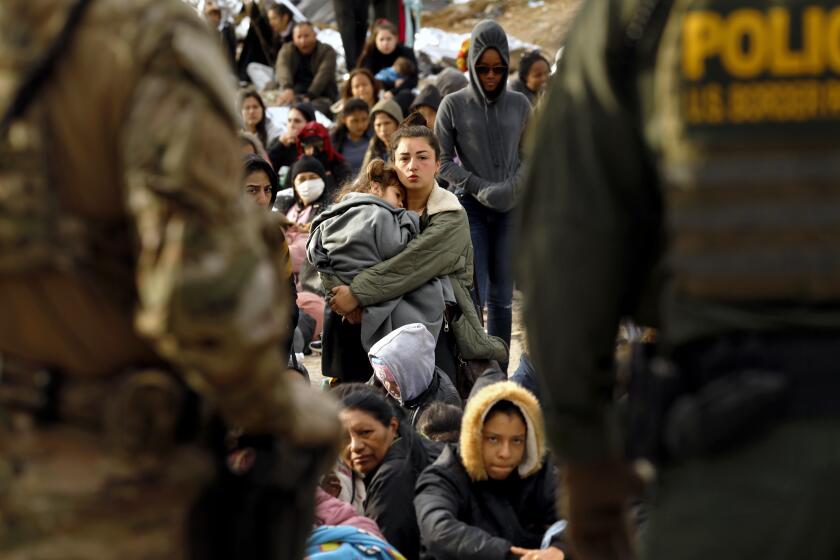Border deaths in Arizona may break record
This year, Arizona became known as the state with the toughest policies against illegal immigration. That’s why Deputy Chief Medical Examiner Eric Peters didn’t think the Pima County coroner would see a surge in migrants killed while trying to cross Arizona’s southern deserts.
But despite beefed-up efforts to stem illegal immigration and an economy that makes work harder to come by, migrants are still trying to get into the country. And many are dying.
In 2007, a record 218 bodies were found in Pima County. This year, the death toll could be worse. Already, authorities have recovered the remains of 170 migrants.
“We’re kind of looking at a record-breaking year this year,” Peters said.
July was the worst month of this year so far, with 59 people found dead. More than half of them died from heat-related causes. On July 15, the deadliest day of the month, seven bodies were found, among them the remains of Omar Luna Velasquez, 25. The high temperature that day was 108 degrees.
To accommodate the bodies in the summer heat, a 50-foot refrigerated trailer truck has been parked in the coroner’s receiving area.
More than 66% of the bodies found this year remain unidentified. Sometimes corpses are reduced to skeletal remains; some are mummified by the sun and shriveled like raisins. Of the seven bodies found July 15, only Luna’s could be identified.
The Pima County Medical Examiner’s Office works closely with the Mexican Consulate to identify remains and locate relatives of the dead. Consular officials inspect the body and any belongings and try to match clues, such as voter registration cards or phone numbers inked on the inside of jeans, with tips that they keep in a database of missing migrants.
“We don’t start from scratch because we have a big whereabouts database,” said Julian Etienne, a spokesman with the Mexican Consulate in Tucson.
Border deaths were sparse throughout the 1990s. But in 2000, the numbers jumped drastically, and four years later the county created a name for the type of person who dies in such a manner: the “undocumented border crosser.”
Increased border enforcement in California moved migration routes east into some of Arizona’s most remote and inhospitable terrain. Unusually hot weather, even by Arizona standards, also may be contributing to the large number of deaths this year.
Some migrants try to time their journeys to the summer monsoon season with its cooling rains, said Kat Rodriguez, who works with the human rights group Coalicion de Derechos Humanos. But July was one of the hottest on record, according to the National Weather Service, and the seasonal rainstorms came late.
“The experience 10 years ago is completely different than now,” Rodriguez said. “It’s brutal and ruthless.”
It’s difficult to know how many people die crossing the Southwest border each year. California’s Imperial County is one of only a handful of counties that keeps track, said Rodriguez, who conducts research with the University of Arizona Binational Migration Institute.
Imperial County, which adjoins Arizona and about 80 miles of Mexican border, hasn’t seen a large number of migrant deaths since the mid-1990s. Through July, the county recorded 16 such deaths. In the last fiscal year, it had 23.
In San Diego County, 10 migrants have been found dead this year. “We used to have a lot more here, lots more here,” said Deputy Medical Examiner Jonathan Lucas.
Kenneth Quillin, a supervising agent for the Border Patrol in Yuma County, Ariz., said he hadn’t seen a death in about 15 months. He attributes the decrease to the border fence and increased enforcement by agents.
“Every mile of the border in Yuma has some sort of barrier,” he said. The enforcement helps push migrants to Pima County and neighboring Cochise County.
Cochise County, in the southeastern corner of the state, has recorded 19 deaths this year. Last year, it had 28. Most of the fatal border crossings in Arizona occur in Pima County.
Oddly, although the number of deaths is on the rise, illegal immigration is down. Apprehensions at the border have dropped 61% in the last fiscal year, compared with 2000. This year, 194,000 people have been apprehended, down 5% from the same time last year.
“Crossing the border isn’t as easy as it was before,” said Omar Candelaria, a spokesman with the Border Patrol in Tucson.
Humanitarian groups such as Humane Borders in Tucson say that the increased law enforcement presence only means that people will go to greater lengths to come to the U.S.
Sofia Gomez, executive director of Humane Borders, said she recently met a woman in Sonora, Mexico, who said that in the 1990s, the journey to the U.S. took hours. Now it’s several days.
Gomez asked the woman if she would cross again.
“She just smiled,” Gomez said. “I could tell right away that she basically didn’t think she had a choice.”
Some human rights groups try to help migrants survive the desert. Humane Borders maintains 100 water stations in Arizona.
Volunteer Lance Leslie, a stocky man with blond hair, was checking water stations near the border recently, driving a white truck through deep sand and a landscape dotted with rattlesnake holes.
“People have been walking in this corridor for years,” Leslie said after refilling a blue 55-gallon barrel. “I have no doubt that these barrels have saved a life.”
But they couldn’t save Omar Luna Velasquez, the 25-year-old found in the desert July 15. His family buried him recently in Mexico.
nicole.santacruz@latimes.com
More to Read
Start your day right
Sign up for Essential California for news, features and recommendations from the L.A. Times and beyond in your inbox six days a week.
You may occasionally receive promotional content from the Los Angeles Times.







